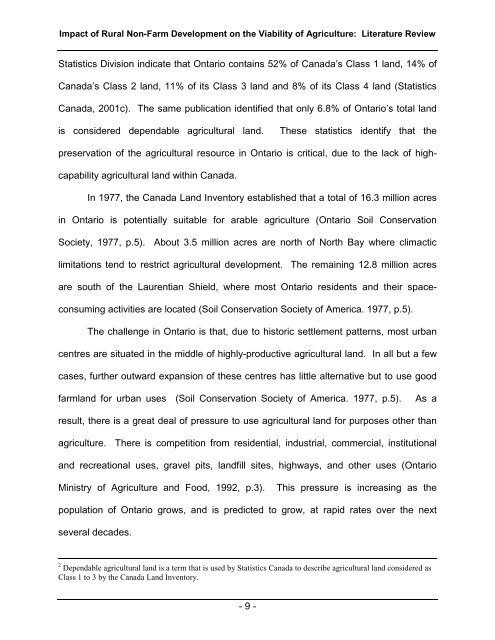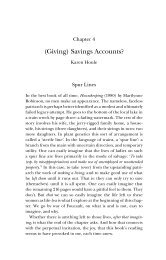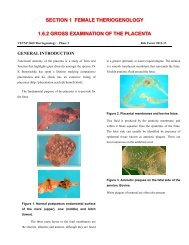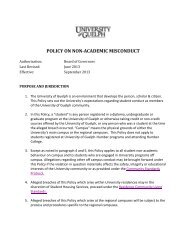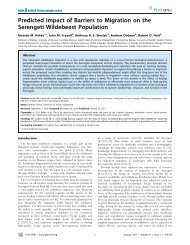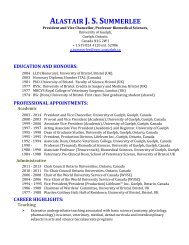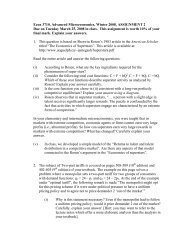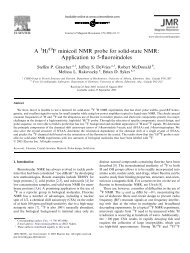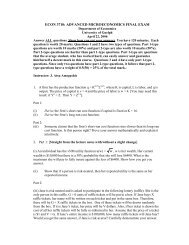An Assessment of the Impact of Rural Non-Farm Development on ...
An Assessment of the Impact of Rural Non-Farm Development on ...
An Assessment of the Impact of Rural Non-Farm Development on ...
Create successful ePaper yourself
Turn your PDF publications into a flip-book with our unique Google optimized e-Paper software.
<str<strong>on</strong>g>Impact</str<strong>on</strong>g> <str<strong>on</strong>g>of</str<strong>on</strong>g> <str<strong>on</strong>g>Rural</str<strong>on</strong>g> <str<strong>on</strong>g>N<strong>on</strong></str<strong>on</strong>g>-<str<strong>on</strong>g>Farm</str<strong>on</strong>g> <str<strong>on</strong>g>Development</str<strong>on</strong>g> <strong>on</strong> <str<strong>on</strong>g>the</str<strong>on</strong>g> Viability <str<strong>on</strong>g>of</str<strong>on</strong>g> Agriculture: Literature ReviewStatistics Divisi<strong>on</strong> indicate that Ontario c<strong>on</strong>tains 52% <str<strong>on</strong>g>of</str<strong>on</strong>g> Canada’s Class 1 land, 14% <str<strong>on</strong>g>of</str<strong>on</strong>g>Canada’s Class 2 land, 11% <str<strong>on</strong>g>of</str<strong>on</strong>g> its Class 3 land and 8% <str<strong>on</strong>g>of</str<strong>on</strong>g> its Class 4 land (StatisticsCanada, 2001c). The same publicati<strong>on</strong> identified that <strong>on</strong>ly 6.8% <str<strong>on</strong>g>of</str<strong>on</strong>g> Ontario’s total landis c<strong>on</strong>sidered dependable agricultural land.These statistics identify that <str<strong>on</strong>g>the</str<strong>on</strong>g>preservati<strong>on</strong> <str<strong>on</strong>g>of</str<strong>on</strong>g> <str<strong>on</strong>g>the</str<strong>on</strong>g> agricultural resource in Ontario is critical, due to <str<strong>on</strong>g>the</str<strong>on</strong>g> lack <str<strong>on</strong>g>of</str<strong>on</strong>g> highcapabilityagricultural land within Canada.In 1977, <str<strong>on</strong>g>the</str<strong>on</strong>g> Canada Land Inventory established that a total <str<strong>on</strong>g>of</str<strong>on</strong>g> 16.3 milli<strong>on</strong> acresin Ontario is potentially suitable for arable agriculture (Ontario Soil C<strong>on</strong>servati<strong>on</strong>Society, 1977, p.5). About 3.5 milli<strong>on</strong> acres are north <str<strong>on</strong>g>of</str<strong>on</strong>g> North Bay where climacticlimitati<strong>on</strong>s tend to restrict agricultural development. The remaining 12.8 milli<strong>on</strong> acresare south <str<strong>on</strong>g>of</str<strong>on</strong>g> <str<strong>on</strong>g>the</str<strong>on</strong>g> Laurentian Shield, where most Ontario residents and <str<strong>on</strong>g>the</str<strong>on</strong>g>ir spacec<strong>on</strong>sumingactivities are located (Soil C<strong>on</strong>servati<strong>on</strong> Society <str<strong>on</strong>g>of</str<strong>on</strong>g> America. 1977, p.5).The challenge in Ontario is that, due to historic settlement patterns, most urbancentres are situated in <str<strong>on</strong>g>the</str<strong>on</strong>g> middle <str<strong>on</strong>g>of</str<strong>on</strong>g> highly-productive agricultural land. In all but a fewcases, fur<str<strong>on</strong>g>the</str<strong>on</strong>g>r outward expansi<strong>on</strong> <str<strong>on</strong>g>of</str<strong>on</strong>g> <str<strong>on</strong>g>the</str<strong>on</strong>g>se centres has little alternative but to use goodfarmland for urban uses (Soil C<strong>on</strong>servati<strong>on</strong> Society <str<strong>on</strong>g>of</str<strong>on</strong>g> America. 1977, p.5).As aresult, <str<strong>on</strong>g>the</str<strong>on</strong>g>re is a great deal <str<strong>on</strong>g>of</str<strong>on</strong>g> pressure to use agricultural land for purposes o<str<strong>on</strong>g>the</str<strong>on</strong>g>r thanagriculture. There is competiti<strong>on</strong> from residential, industrial, commercial, instituti<strong>on</strong>aland recreati<strong>on</strong>al uses, gravel pits, landfill sites, highways, and o<str<strong>on</strong>g>the</str<strong>on</strong>g>r uses (OntarioMinistry <str<strong>on</strong>g>of</str<strong>on</strong>g> Agriculture and Food, 1992, p.3). This pressure is increasing as <str<strong>on</strong>g>the</str<strong>on</strong>g>populati<strong>on</strong> <str<strong>on</strong>g>of</str<strong>on</strong>g> Ontario grows, and is predicted to grow, at rapid rates over <str<strong>on</strong>g>the</str<strong>on</strong>g> nextseveral decades.2 Dependable agricultural land is a term that is used by Statistics Canada to describe agricultural land c<strong>on</strong>sidered asClass 1 to 3 by <str<strong>on</strong>g>the</str<strong>on</strong>g> Canada Land Inventory.- 9 -


